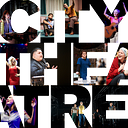The History Behind PARADISE BLUE
by Meg Knorr, Marketing Intern | City Theatre Company

If you’ve ever walked through Pittsburgh’s Hill District, you may have come across a tall, abandoned building standing on the corner of Wylie Avenue and Elmore Street. Rusted metal reads: “1917 SOCHATOFF BUILDING,” as a loose panel dangles dangerously off the faded-brick exterior. The only clue of the past is a little blue sign, so small you almost miss it, that reads:
CRAWFORD GRILL
A center of Black social life where musicians such as Art Blakely, Mary Lou Williams, John Coltrane drew a racially mixed, international clientele. Here, Crawford Crill #2, the second of three clubs opened 1943; was owned by William (Gus) Greenlee, later by Joseph Robinson.
It is the ghost of a rich culture that has since been pushed out; a relic to the vibrant nightlife that was once the epicenter of jazz music in Pittsburgh.
. . .
This is just a glimpse of the devastation caused by urban renewal projects of the 1950s and 60s, a topic tackled by City Theatre’s upcoming show, Paradise Blue by Dominique Morisseau. Paradise Blue takes us to a gentrifying Detroit for a haunting drama laced with jazz and intrigue. It’s 1949 and club-owner and trumpeter Blue must choose between escaping his demons and the human cost of leaving the only home he’s ever known.
While Blue’s story may be fictional, the choice he faced between standing his ground or being pushed out of his home was a reality for many Black-indigenous artists of color in cities across America. The parallel between the destruction of Detroit’s and Pittsburgh’s jazz scenes is too blatant to ignore, which is one of the reasons Paradise Blue was chosen for City Theatre’s 2021–2022 subscription season. In the 1930s and 40s, these neighborhoods were some of the most influential jazz scenes in the country, sharing performers like Ella Fitzgerald and Louis Armstrong, and both of these communities saw that brightness extinguished in the wake of urban renewal.
After World War II, local governments used urban renewal projects in an attempt to revitalize U.S. cities. Billions of dollars were dumped into replacing existing neighborhoods with highways, shopping malls, and brand-new housing. Unfortunately, most of that brand-new housing was more expensive than current residents could afford, and they were forced out of their homes. These projects resulted in the displacement of over 300,000 people across America between 1955–1966 (National Geographic).
Let’s dive a little deeper into urban renewal’s effects on the setting of Paradise Blue: Detroit, Michigan.
In the early 1900s, the auto industry created thousands of jobs for BIPOC workers. Segregation and discriminatory housing were prevalent issues at the time, so Black workers had few options to choose from in terms of living spaces. Paradise Blue takes place in one of these real-life neighborhoods: Black Bottom, located on what was formerly known as Hastings Street.

In the 30s and 40s, Hastings Street was buzzing with nightlife. Detroiters of all races hit the strip known as Paradise Valley to check out the hottest nightclubs, cabarets, eateries, and gambling spots. The strip was so hopping that Paradise Valley was often called Detroit’s Las Vegas. It was a rare scene of racial and social mingling during a time of segregation that provided Black artists the opportunity to perform for a wider audience, AND for compensation.
Some of the biggest names in jazz history performed in Black Bottom and Paradise Valley: Duke Ellington, Billie Holiday, Ella Fitzgerald, Dinah Washington, Count Basie, and others. The neighborhood over saw Duke Ellington, Ella Fitzgerald, and Billy Holiday, along with Nat King Cole, Sammy Davis Jr., and Louis Armstrong. Paradise Valley’s impact on music was right up there with Harlem and New Orleans.

By the 50s, jazz had made its way from Black Bottom to the rest of the city, but after World War II, city officials decided to wage a new war against the vibrant communities along Hastings Street. Mayor Albert Cobo drew up the Detroit Plan, which would raze the Black Bottom neighborhood in order to build freeways, hospitals, housing, and other infrastructure changes. With no plans to rehouse the neighborhood’s residents, the plan was dubbed a “Jim Crow project” by the Black-owned Michigan Chronicle.
Tens of thousands of poor and mostly BIPOC community members’ homes and businesses were purchased and destroyed without their permission, and their once vibrant community was paved over by the Chrysler Freeway.
Though few physical relics serve as a reminder of the community that once was, its spirit lives on in the music it produced and the legends it fostered. If you want to know more about Black Bottom, community historians like the team at Black Bottom Archives have given the community new life on the Internet. Anyone can explore their website to discover historical maps, figures, sites, and oral histories that amplify “the voices, experiences, and perspectives of Black Detroiters through digital storytelling, journalism, art, and community organizing with a focus on preserving local Black history & archiving our present.”
…
Paradise Blue opens at City Theatre on Friday, March 18, 2022, and runs until Sunday, April 3, 2022. Pick-Your-Price Previews run March 12–17. Tickets start at $5 and increase incrementally. Available online, in person, or over the phone. Phone and online fees apply. Each price point is subject to availability — so purchase early!
Further Reading:
